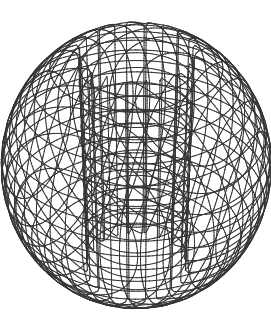
|
|
A spherical ring is a sphere with a cylindrical hole cut so that the centers of the cylinder
and sphere coincide, also called a napkin ring. Let the
sphere have radius and the cylinder radius
.
From the right diagram, the surface area of the spherical ring is equal to twice that of a cylinder of half-height
|
(1)
|
and radius
plus twice that of the zone of radius
and height
, giving
|
(2)
| |||
|
(3)
|
Note that as illustrated above, the hole cut out consists of a cylindrical portion plus two spherical caps. The volume of the entire cylinder is
|
(4)
|
and the volume of the upper segment is
|
(5)
|
The volume removed upon drilling of a cylindrical hole is then
|
(6)
| |||
|
(7)
|
where the expressions
|
(8)
| |||
|
(9)
|
obtained from trigonometry have been used to re-express the result.
The volume of the spherical ring itself is then given by
|
(10)
| |||
|
(11)
| |||
|
(12)
|
By the final equation, the remaining volume of any center-drilled sphere can be calculated given only the length of the hole. In particular, if the
sphere gets bigger while remains constant, then the circumference of the ring gets
bigger, increasing the volume, but the ring gets narrower, decreasing it. The two
effects exactly cancel each other out, leading Gardner (1959, pp. 113-121)
to term this an "incredible problem."
The volume can also be found more easily by looking at cross-sections orthogonal to the axis. It then turns out that the area of the cross section does not depend
on ,
leading to the above result.
The centroid of the spherical ring is at the origin, the mean square (spherical) radius is
|
(13)
|
and the moment of inertia about the origin is given by
![I=[1/2MR^2-1/(40)ML^2 0 0; 0 1/2MR^2-1/(40)ML^2 0; 0 0 MR^2+3/(20)ML^2].](/images/equations/SphericalRing/NumberedEquation5.svg) |
(14)
|